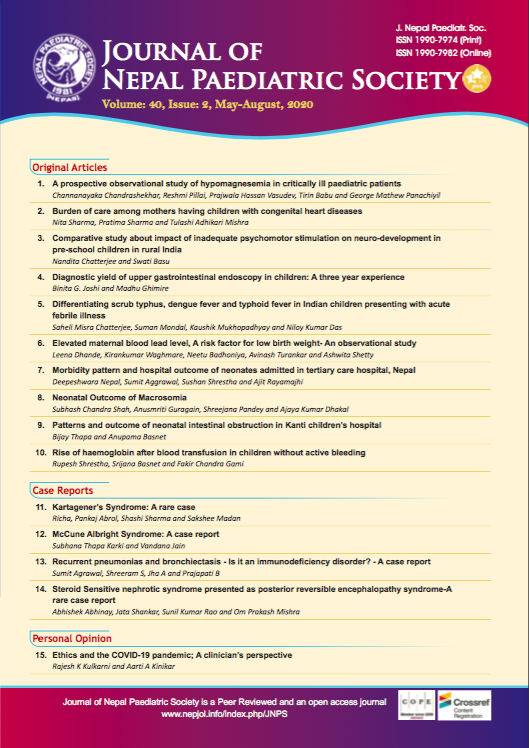Morbidity Pattern and Hospital Outcome of Neonates Admitted in Tertiary Care Hospital, Nepal
DOI:
https://doi.org/10.3126/jnps.v40i2.29469Keywords:
morbidity, mortality, neonates, prematurity, sepsisAbstract
Introduction: The first 28 days of life, neonatal period is crucial as neonates are susceptible to sepsis, birth asphyxia, hypoxic injuries and its consequences which may lead to lifelong morbidity. Knowing the causes of morbidity and mortality is an essential step to improve neonatal health. The aim of this study is to describe the pattern and causes of neonatal admission, immediate hospital outcome in the form of improved, died or left against medical advice and factors associated with its outcome.
Methods: This was a retrospective hospital based study carried out in Neonatal Intensive Care Unit (NICU) of Kanti Children’s Hospital, Kathmandu, Nepal over a period of six months (February 2019 to July 2019 AD). Neonatal details including age, sex, gestational age, birth weight, and maternal age and parity, mode of delivery, place of delivery, neonatal morbidities and neonatal outcomes were recorded in a predesigned performa. Results were expressed as mean, percentage and p value. P- value was calculated by using chi-square test.
Results: A total of 163 neonates were admitted during the study period, among which 106 (65%) were males. The mean birth weight was 2483.96 ± 812.63 gm. Among admitted newborns 130 (79.8%) had good outcome, babies born to young mothers (< 20 years of age) had poor outcome which is statistically significant with p value of 0.002. Neonates whose birth weight were < 1000 gram had significantly poor outcome (0.001).
Conclusion: Common causes of NICU admission were neonatal sepsis, neonatal hyperbilirubinemia, prematurity and perinatal asphyxia. Babies born to young primipara mothers, extremely low birth weight, extremely premature babies and babies undergoing mechanical ventilation had poor outcome.
Downloads
Downloads
Published
How to Cite
Issue
Section
License
Authors who publish with this journal agree to the following terms:
Authors retain copyright and grant the journal right of first publication with the work simultaneously licensed under a Creative Commons Attribution License that allows others to share the work with an acknowledgement of the work's authorship and initial publication in this journal.
Authors are able to enter into separate, additional contractual arrangements for the non-exclusive distribution of the journal's published version of the work (e.g., post it to an institutional repository or publish it in a book), with an acknowledgement of its initial publication in this journal.
Authors are permitted and encouraged to post their work online (e.g., in institutional repositories or on their website) prior to and during the submission process, as it can lead to productive exchanges, as well as earlier and greater citation of published work (See The Effect of Open Access).



